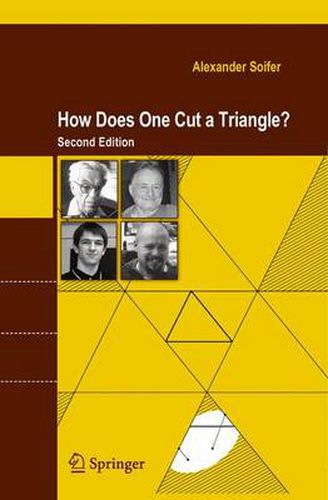Readings Newsletter
Become a Readings Member to make your shopping experience even easier.
Sign in or sign up for free!
You’re not far away from qualifying for FREE standard shipping within Australia
You’ve qualified for FREE standard shipping within Australia
The cart is loading…






This title is printed to order. This book may have been self-published. If so, we cannot guarantee the quality of the content. In the main most books will have gone through the editing process however some may not. We therefore suggest that you be aware of this before ordering this book. If in doubt check either the author or publisher’s details as we are unable to accept any returns unless they are faulty. Please contact us if you have any questions.
This second edition, How Does One Cut a Triangle? , shows how different areas of mathematics can be intertwined to solve a given problem. Soifer brings together geometry, algebra, trigonometry, linear algebra, and rings in a juxtaposition of different mathematical areas that enables mathematics to come alive. In the process the reader is given a taste of what mathematics can do and how mathematicians go about their research. How Does One Cut a Triangle? contains many analytical proofs and counterexamples such as a pool table problem, fifty-dollar problem, five-point problem, and joint problem. By proving these additional examples, Soifer proves that research is a collection of mathematical ideas that have been developed throughout the course of history. Review of the first edition: It is impossible to convey the spirit of the book by merely listing the problems considered or even a number of solutions. The manner of presentation and the gentle guidance toward a solution and hence to generalizations and new problems takes this elementary treatise out of the prosaic and into the stimulating realm of mathematical creativity.Not only young talented people but dedicated secondary teachers and even a few mathematical sophisticates will find this reading both pleasant and profitable.
The Mathematical Reviews Originally self-published by Alexander Soifer, 1990 at the Center for Excellence in Mathematical Education, Colorado Springs, CO.
$9.00 standard shipping within Australia
FREE standard shipping within Australia for orders over $100.00
Express & International shipping calculated at checkout
This title is printed to order. This book may have been self-published. If so, we cannot guarantee the quality of the content. In the main most books will have gone through the editing process however some may not. We therefore suggest that you be aware of this before ordering this book. If in doubt check either the author or publisher’s details as we are unable to accept any returns unless they are faulty. Please contact us if you have any questions.
This second edition, How Does One Cut a Triangle? , shows how different areas of mathematics can be intertwined to solve a given problem. Soifer brings together geometry, algebra, trigonometry, linear algebra, and rings in a juxtaposition of different mathematical areas that enables mathematics to come alive. In the process the reader is given a taste of what mathematics can do and how mathematicians go about their research. How Does One Cut a Triangle? contains many analytical proofs and counterexamples such as a pool table problem, fifty-dollar problem, five-point problem, and joint problem. By proving these additional examples, Soifer proves that research is a collection of mathematical ideas that have been developed throughout the course of history. Review of the first edition: It is impossible to convey the spirit of the book by merely listing the problems considered or even a number of solutions. The manner of presentation and the gentle guidance toward a solution and hence to generalizations and new problems takes this elementary treatise out of the prosaic and into the stimulating realm of mathematical creativity.Not only young talented people but dedicated secondary teachers and even a few mathematical sophisticates will find this reading both pleasant and profitable.
The Mathematical Reviews Originally self-published by Alexander Soifer, 1990 at the Center for Excellence in Mathematical Education, Colorado Springs, CO.